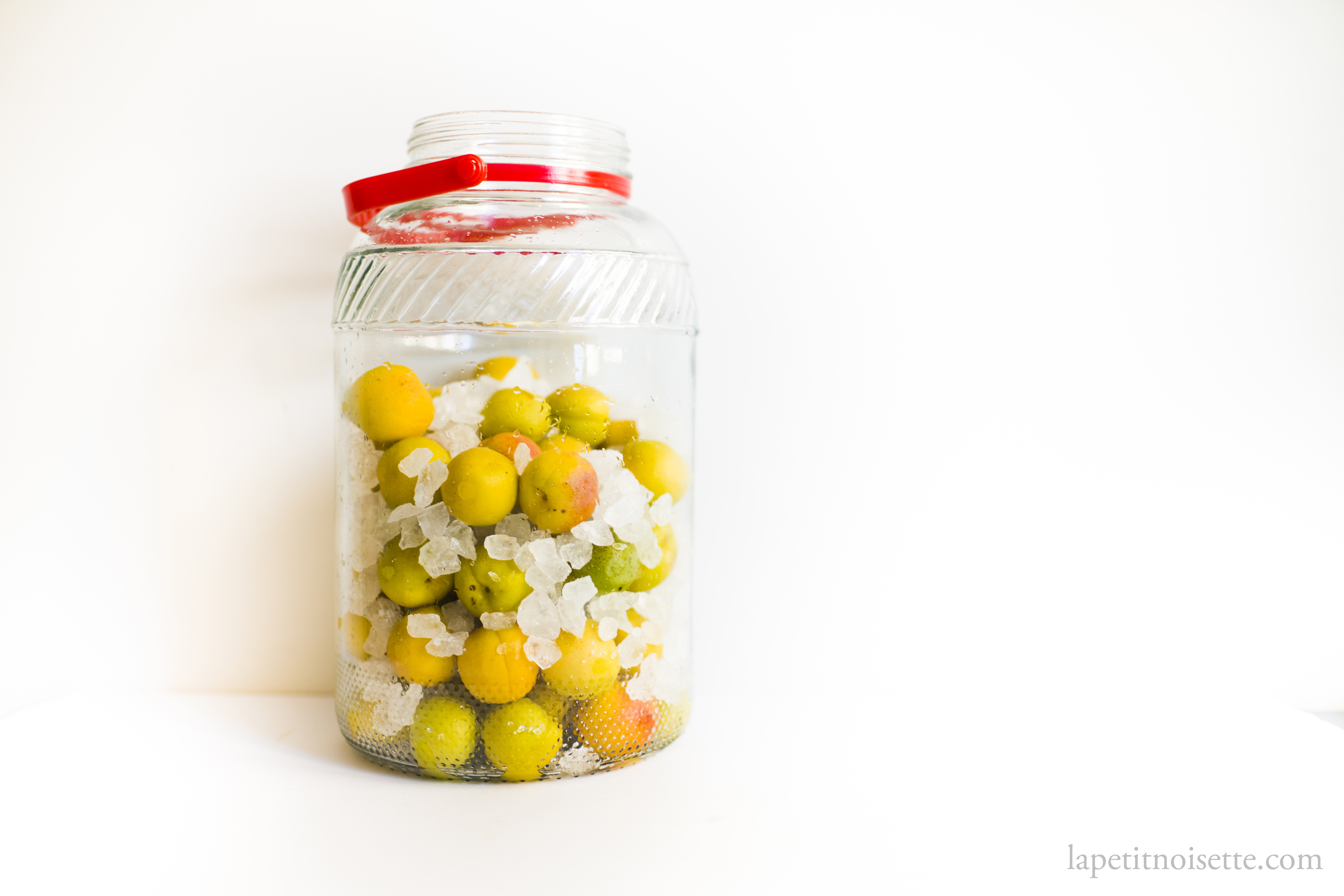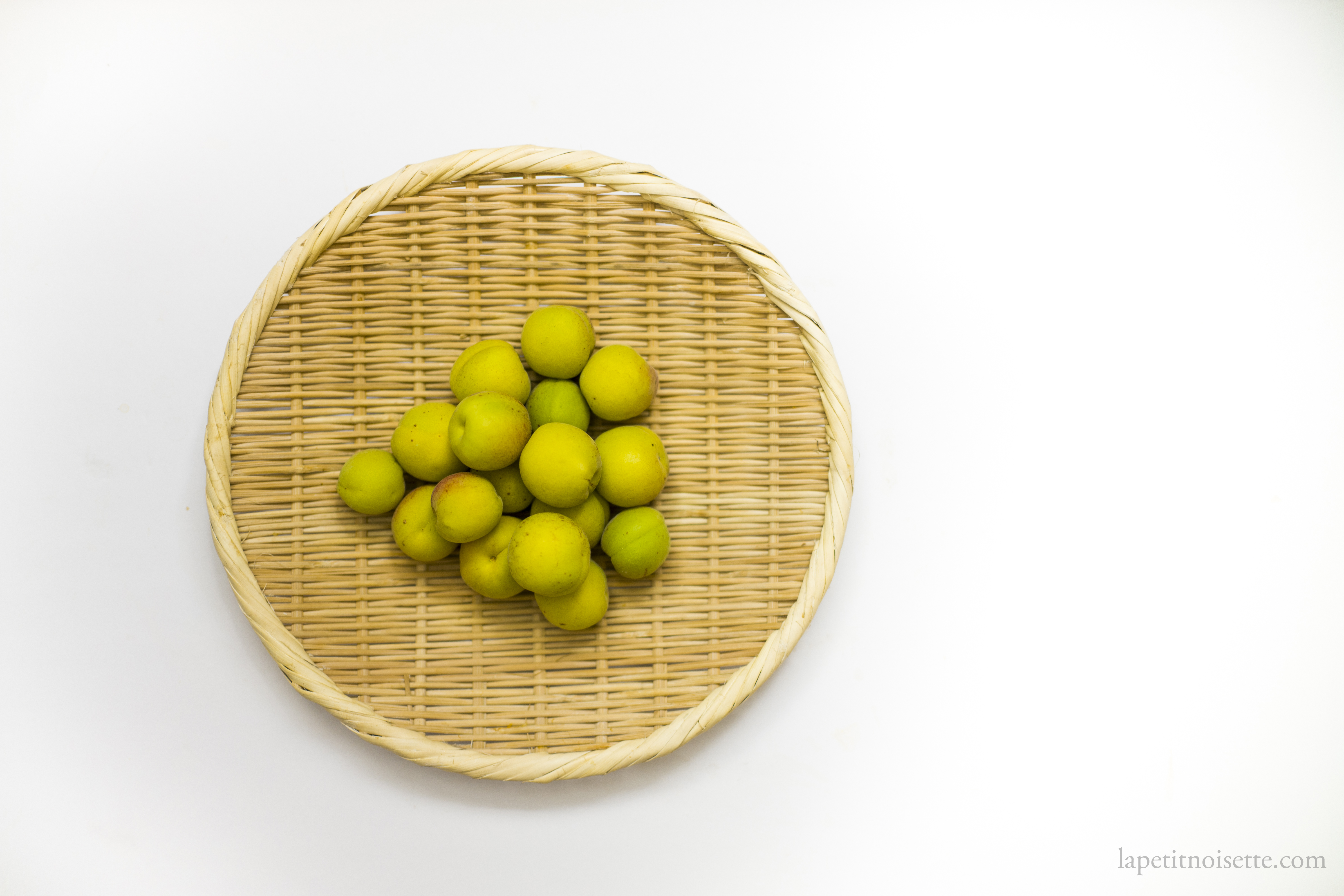Recipe for making umeshu from green unripe apricots (青あんず酒の作り方)

If you were to look at most umeshu and most umeboshi recipes on the internet or in books by famous authors, they all always quote the same thing, which is that umeshu and umeboshi may be made from apricots, but they’re unsure if the final product would be similar or not.
Umeshu (梅酒), or Japanese plum wine is a liquor made by steeping unripe Japanese plums (ume/梅) in fruit liquor or shochu (焼酎), a kind of Japanese distilled spirit. For people living outside Japan, this can be particularly frustrating if you can’t find a supply of Japanese plums (ume/梅) to make their recipes. To help solve this problem, I went on a journey to source apricots and plums to experiment with to see if there was a viable way to make umeshu or at least something similar to it. In this article, we’re going to see how we can make umeshu using apricots with a few caveats.
Before I dive into the testing, let’s do some standardizations. I’d previously written an article for black sugar umeshu that deviates from the normal recipe but contains more information on making normal umeshu if you can source Japanese plums. However, there actually exists a universal standardised recipe that people use to make umeshu, that is:
- 1kg of green unripe Japanese plums
- 500 to 800g of rock sugar
- 1.8 Litres of at least 35% ABV plain liquor
This is because during the season for Japanese plums, most supermarkets will sell specialized 3 litre sized jars with classic red lids that will just fit the recipe above. 800g of rock sugar per 1kg of plums is for the slightly sweeter kind of umeshu that is meant to be diluted with ice, whilst 500g of rock sugar is for those who prefer to drink it neat or who enjoy a strong emphasis on the ume flavour.
The tests done for this article followed this standardized recipe and were made in the same 3 litre jars with red lids, only substituting out the green unripe Japanese plums for other fruit.
Whilst plums and apricots are both in the Prunus genus, Japanese plums (Prunus mume) are actually more closely related to apricots. Therefore, our best bet is to make umeshu from apricots instead of plums. However, there’s a big catch, which is that the Japanese plums used to make umeshu are always harvested when they’re green and unripe, while any apricot or plum you’ll find are typically already ripe. You’ll notice this if you’ve ever looked at the pictures in umeshu recipes. This makes sense because who would buy unripe apricots or plums unless you lived in a country with a tradition of making fruit liquor from unripe fruit? If you actually let Japanese plums fully ripen, they actually look indistinguishable from apricots with the same yellowish colour and the occasional red hue. Taste-wise, even a fully ripe Japanese plum is much less sweet and much more sour compared to a fully ripe apricot, most likely because Japanese plums have been bred for many generations to be harvested while unripe, whilst apricots have been selected for their suitability as table fruit. Interestingly enough, the converse is also true, a completely unripe apricot is indistinguishable from an unripe Japanese plum in the way that they’re completely green and hard to the touch. The same is also true for an unripe plum. When ripe however, plums are quite soft and are typically a dark red colour with a completely different flavour profile to apricots and Japanese plums.
I started out by steeping ripe plums and ripe apricots using the above standard recipe and the resulting fruit liquor after 3 months was nothing like umeshu. The liquor using the ripe apricots was reminiscent of umeshu but was much richer and lacked acidity. The results of this test aren’t really a surprise given that already exists names for these two fruit liquors in Japanese, puramushu (プラム酒) for plum wine and anzushu (あんず酒) for apricot wine, hinting that they taste different enough to have their own terms. Interestingly enough, if you search for apricot wine in katakana, (Apurikottoshu/アプリコット酒), all the results you get are for the French creme d’abricot.
Trying again with green unripe plums also yielded a fruit liquor that I wouldn’t call similar to umeshu, but the real magic happened when green unripe apricots were used. The resulting liquor was basically indistinguishable from umeshu. It was actually very hard to obtain green unripe apricots, and it needed me to specifically contact a farmer directly who was kind enough to pick some from his orchard before they ripened. There are surprisingly close to no resources on the Japanese internet for making umeshu from green apricots, most like because people living in Japan have a plentiful supply of ume to make umeshu so they’d never have to consider making them from unripe green apricots (青あんず). I also repeated the experiment with apricots that are just about ripening (ほぼ完熟) which are more suitable for making umeboshi but are still sometimes used to make umeshu. The resulting umeshu was very rich with a stronger flavour but lacked acidity, which also makes sense because apricots are already much less acidic compared to Japanese plums to begin with.

TLDR: Can you substitute Japanese ume with apricots when making umeshu?
After all the testing, my conclusion is that you can make umeshu using apricots, but only if you use completely green unripe apricots. The reasoning behind this is that Japanese ume have been bred specifically for making umeshu and not for consumption and thus have been selected for a high acidity level. Apricots have much lower acidity as they’re meant to be consumed and so even in it’s green unripe form, it has lower acidity compared to Japanese ume. Can you notice a difference in the resulting umeshu? If you use the higher end of the typical sugar used (~800g), the lack of acidity to balance out the sweetness starts to become quite apparent and the umeshu can start to become sickly sweet if not diluted with ice. However, if you choose to use less sugar (~500g), the umeshu made from green apricots is pretty indistinguishable from one made from Japanese ume.
In the end, I found that I prefer umeshu made from around 50% completely green unripe apricots for the acidity, and 50% from apricots which are just turning yellow for the added flavour (not mentioned in the recipe). I also found 650g of sugar just about right for my taste. Fully yellow apricots didn’t work as the umeshu started to taste more like apricots than ume even though I don’t think most people will be able to tell the difference.
Green apricot umeshu recipe
For a 3 litre sized glass jar
1kg unripe apricots
1800ml Japanese white liquor (ホワイトリカー) or any neutral spirit of at least 35% alcohol
500g white rock sugar
- Check the quality of each individual fruit, remove any fruits that are bruised or starting to rot as they risk ruining your entire batch of wine.
- Carefully use the tip of a paring knife or a toothpick to remove the ends of the stems on the tip of the fruit. This should be easy to do.
- Wash the apricots in cold water to remove any dirt on them. Be careful not to bruise them while washing.
- Pour about a tablespoon of neutral spirit into the jar and use a clean cloth to wipe down the inside of the jar. This step sanitises the jar.
- Add in a layer of the apricots at the bottom followed by a layer of white rock sugar.
- Repeat until all the apricots and rock sugar are in the jar.
- Pour in all the neutral spirit and close the lid.
- Leave in a cool, shady spot for at least 3 months before drinking.
- After 12 months, strain out apricots which can be used to make jam.
Notes
Some umeshu recipes say to soak the fruits overnight to remove some of the astringency in the fruit but the fruit also absorbs water over time which will dilute the final taste of your product so a quick wash will do.
3 months is the minimum age before you can start to drink your umeshu. During this time, you should notice your fruit float to the top when you first add the alcohol before slowly starting to sink to the bottom of the jar. At 3 months, I recommend tasting your umeshu to see if it’s still to your taste. If the alcohol still tastes rather harsh, leave it for a few more months to mellow out.
Sunlight causes the wine quality to degrade faster which is why you should store your umeshu in a cold shady place. Otherwise, wrap the jar with newspaper.
Safety
Several of the common fruits we eat such as plums, apricots, apples, almonds and cherries contain amygdalin which can break down into cyanide which is poisonous in high enough concentrations. Amygdalin is particularly concentrated in the pith of stone fruit and does leach in small quantities into the liquor. For this recipe, the apricots are left whole and so the alcohol has relatively little surface area to contact and won’t be able to extract as much amygdalin and so safety isn’t an issue. Japanese apricots also contain amygdalin which means that all commercially umeshu contains amygdalin. Some recipes for fruit liquor are made from only the seeds or pits of fruits without the flesh. It’s only in these recipes that you’ll have to start worrying about the amygdalin levels in your liquor.
Thanks for the detailed recipe and your findings. These I found very useful for what I do. I live in India and use Himalayan plums for my variant of Umeshu like drink. I wo’nt call it Umeshu, but it tastes very good. I am about to start making it from himalayan apricots from our native place of Shimla. So was looking for recipe and instructions. your write up was very handy. Thanks again.